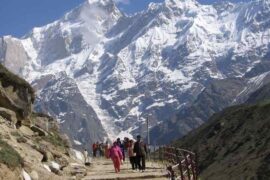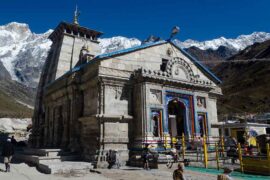Unbelievable Kedarnath Shivling: Original Image, Photo & Story
The fifth Jyotirlinga of Lord Shiva is located in Uttarakhand. Its name is Kedarnath. This temple is also one of the Char Dhams of Uttarakhand. The history of this holy shrine of Lord Shiva is associated with Lord Vishnu’s incarnations Nar and Narayan, the Pandavas, and Adi Guru Shankaracharya.
This temple is situated in the Himalayan region, and because of this, it remains closed for about six months during the winter season and is opened for devotees during the summer season. Let’s know some special facts related to this fifth Jyotirlinga…
The Shivling of Kedarnath (Kedarnath Yatra 2025) is not only special because of its unique shape, but it also symbolizes deep faith and mythological stories that make it even more mystical. So, in this article, let us know why the Shivling of Kedarnath is different from other Shivlings.
Kedarnath Dham is one of the twelve Jyotirlingas. It is known not only for its natural beauty but also for its religious significance. Here, the Shivling is worshipped in the vigraha form, which is triangular in shape, resembling the back of a bull. The glory of this unique form of Bholenath is immense, so let us take a look at the beliefs and legends associated with it.

Bholenath Was Angry With The Pandavas
It is believed that after the Mahabharata war, the Pandavas wanted to attain liberation from the sin of killing their own brothers. Therefore, they went to Kashi to seek blessings from Lord Shiva.
But Lord Shiva was angry with them and did not want to meet them. Hence, he disguised himself as a bull and hid in Guptkashi. The Pandavas followed Bholenath in search of him all the way to Garhwal.
Bheem recognized a bull among a herd of others and tried to catch it. Then Lord Shiva in the form of the bull began to sink into the ground, but Bheem caught the hump part of its back.
Triangular Shivling (Kedarnath Shivling)
It is said that the triangular Shivling worshipped in Kedarnath represents the back of that bull. It is believed that Lord Shiva’s face appeared in Nepal as Pashupatinath, his arms at Tungnath, navel at Madhyamaheshwar, and hair at Kalpeshwar. These five places are known as the Panch Kedar.
Other Reasons (Kedarnath Yatra 2025, Spiritual Mystery)
Apart from this legend, the shape of the Shivling of Kedarnath can also be seen as a symbol of the natural forces of the Himalayas. Despite facing snow, cold, and other natural calamities for centuries, this Shivling stands firm in its place, representing the immovable and indestructible form of Lord Shiva.

Lord Shiva Appeared, Pleased with the Austerities of Nar and Narayan
Many beliefs and legends are associated with Kedarnath Dham. According to the Kotirudra Samhita of the Shiva Purana, in ancient times, Lord Vishnu’s incarnations Nar and Narayan used to worship Lord Shiva daily by making a Shivling out of clay (Parthiv Shivling) in Badrivan.
The Kedarnath Temple is located in the Rudraprayag district of Uttarakhand. It is one of the twelve Jyotirlingas and also one of the Char Dhams of Uttarakhand. As mentioned in the Shiva Purana, Nar and Narayan used to perform daily worship of Lord Shiva by creating a Parthiv Shivling in Badrivan.
Pleased with the devotion of Nar and Narayan, Lord Shiva appeared before them. Lord Shiva then asked them to request a boon. Nar and Narayan requested that Lord Shiva should always remain present at that place, so that other devotees could also easily have His darshan.
Hearing this, Lord Shiva said that from now on, He would always reside there, and that the region would be known as Kedarkhand (the land of Kedar).
Suggested Read: Rudra Meditation Cave Kedarnath – How to Book?

Kedarnath
Guru Shankaracharya Renovated the Temple
It is believed that a self-manifested (Swayambhu) Shivling is established in Kedarnath Dham. The term Swayambhu Shivling means one that appeared on its own. The Kedarnath Temple was originally constructed by the Pandava king Janamejaya, and later, Adi Guru Shankaracharya carried out its renovation (restoration).
Other Important Facts Related to the Temple
The Kedarnath Temple is built on a high platform. Around the main sanctum (Garbha Griha) and the mandapa (hall), there is a path for circumambulation (Parikrama Marg).
In the temple courtyard, the sacred bull Nandi, the vehicle of Lord Shiva, is seated. The worship of Lord Shiva here is performed following ancient rituals that have been in practice since old times.
Early in the morning, the Shivling is bathed, and a layer of ghee is applied to it. After that, Lord Shiva is worshipped with incense, lamps, and other offerings, followed by an Aarti. In the evening, a special adornment (Shringar) of the deity is performed.
How to Reach Kedarnath
Kedarnath is located in the Rudraprayag district of Uttarakhand. To reach Kedarnath, one can first travel to Haridwar, Rishikesh, or Dehradun. From these cities, buses and taxis are available to reach Gaurikund, the base point for the temple. Haridwar, Rishikesh, and Dehradun are well connected to major cities across the country by various means of transportation.
After reaching Gaurikund, the remaining distance of about 16 kilometers to Kedarnath Temple can be covered on foot, or with the help of a palanquin (Palki) or horse/mule.
Kedarnath Shivling Kedarnath Shivling Kedarnath Shivling Kedarnath Shivling Kedarnath Shivling Kedarnath Shivling Kedarnath Shivling




Comments are closed.